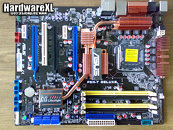Friday, November 23rd 2007

ASUS P5N-T Deluxe nForce 780i Motherboard Preview
ASUS P5N-T Deluxe will be the firm's nForce 680i series successor. Brought to fix some of the nForce 680i bugs, the ASUS P5N-T Deluxe uses NVIDIA's soon to be released nForce 780i chipset, which is in fact a 680i with an added additional PCIe 2.0 bridge. The six pages long preview shows pretty much everything from specs to board layout and heatsink design.
ASUS P5N-T Deluxe nForce 780i Motherboard Preview
Source:
HardwareXL
ASUS P5N-T Deluxe nForce 780i Motherboard Preview


10 Comments on ASUS P5N-T Deluxe nForce 780i Motherboard Preview
What does this mean?
Well, it means your PCIe 2.0 card will basically be bottlenecked at PCIe 1.1 speeds when communicating to the CPU. False marketing from NVIDIA.
Here's a simple diagram of their "bridge":
. PCIe 1.1 upstream port to HOST
..........______|_____
.........|..................|
.........|...."Bridge"....|
.........|..................|
.........|___________|
.............| | | |
. PCIe 2.0 downstream ports to PCIe slots.
The only improvement that you may see with this is that communicating between other GPU's through the PCIe slot will be at 2.0 speeds (which is highly unlikely because NVIDIA uses their SLI bridge connector, not the slot).
AMD has TRUE PCIe 2.0 so EVERYTHING will be happening at 2.0 speeds.
I'm not gonna buy an nVidia board ever again, it's always gonna be Intel or AMD based from now on.
On the server side of things 2.0 is way more important. Fewer lanes are needed for high bandwidth cards, which means more 4x/8x slots on server mobo's. This gives much more room for expandability, scalability, and longevity.
In terms of this bridge, it is mainly for marketing, and compatibility.
I just mention this just in case any of our less experienced members or visitors think that with a PCI-E 2.0 Gfx card they can plug it into a PCI-E 2.0 enabled slot on a motherboard and magically there is extra bandwidth/speed actually there, well it is there in so much as it's available, it is just not being used. Damn I'm confused now :eek: